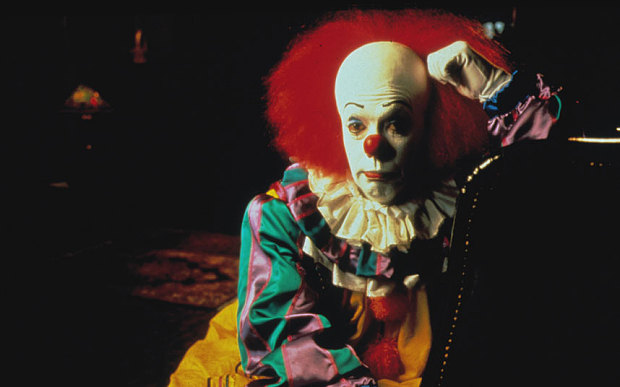
© Rex FeaturesClowns, such as this one in Stephen King's It, have always been figures of fear
Let's be honest, does anybody nowadays really like clowns?
Certainly not in France. There has been a spate of reports this week of people dressed as clowns, some armed with pistols, knives and baseball bats, wreaking havoc in towns across the country. In Montpellier, a clown was arrested after attacking a pedestrian with an iron bar, and, in the nearby town of Agde, police arrested 14 teenagers dressed as clowns and carrying weapons.
The phenomenon has even prompted what has been described as "anti-clown vigilantism", and follows on the heels of
reports of clowns stalking towns in California armed with knives and baseball bats. Nobody would pretend circus life is easy, but have things really got this bad?
Blame has been placed on everything from - inevitably - the internet to the popularity of a television series
American Horror Story: Freak Show, featuring a serial killer called Twisty the Clown. As the actor Lon Chaney Jr, who spent a lifetime terrifying cinema audiences in the guise of various wolf men and monsters, once observed: "There is nothing laughable about a clown in the moonlight." And as these latest incidents suggest, if you wish to strike unease and terror into the hearts of people there is no more potent disguise than the garishly painted white face and fright wig of the clown.
In a sense, they always were figures of fear. The character of the clown - as jester, or fool - goes back to Roman times, a figure who was given license to poke fun at symbols of power and authority - the fool who is not a fool at all - but who also portended something more anarchic and subversive, if not malevolent.
The clown's make-up was a mask for mischief, hinting at a deeply disturbed personality. Joseph Grimaldi was the Regency actor whose guise of whitened face, heavily rouged cheeks and tuft of startling blue hair was the model for the appearance of the clown as we know him now. The son of a serial philanderer who would feign death in front of his children, Grimaldi was a depressive and alcoholic, and plaintively complained: "I make you laugh at night but am Grim-all-day". His energetic slapstick performance led to his early death at the age of 58 from what the coroner recorded as "a visitation from God". His son, who followed in his father's footsteps as a clown, died of alcoholism at the age 30.
The 18th-century mime Jean-Gaspard Deburau, the most celebrated personification of the traditional figure of the Pierrot, was equally troubled. Taunted by a young boy while strolling on the street with his family, Deburau clubbed the boy to death with his cane. He was acquitted of murder, but could not escape the verdict of his biographer that as a man he was "bitter, vindictive, and unhappy".
Charlie Cairoli, the most famous British clown of the post-war period, who performed for 40 consecutive years at the Blackpool Tower Circus, rather bucked the trend by being happily married for 45 years and dying peacefully in his sleep at the age of 70. Cairoli embodied a more innocent era when families could sit at a ringside happy in the knowledge that they would face nothing more threatening than having a bucketful of confetti thrown over them.
But those days are gone. In recent years the figure of the clown has taken on an altogether more sinister aspect. For that, we can thank a man named John Gacy. The manager of three Kentucky Fried Chicken outlets in Waterloo, Iowa, vice-president of his local chamber of commerce (motto: "Service to humanity is the best work of life"), and member in good standing of the "Jolly Joker" clown club, who entertained at children's parties as Pogo the Clown, in 1980 Gacy was convicted of the murder of 33 teenage boys and young men, 26 of whom he buried under his home. He was executed in 1994.
It is to the "Killer Clown", as Gacy was dubbed by newspapers, that we owe the proliferation of murderous clowns in Hollywood films such as
Clownhouse ("Three escaped mental patients go on a killing spree after taking the identities of travelling circus clowns") and, most successfully, Steven Spielberg's horror film
IT, depicting a child-murdering monster in the guise of a demonic clown.
This changing perception of clowns has given rise to a condition known as coulrophobia, or fear of clowns - a curious phenomenon that is not to be found in any psychological textbook, but which is claimed to give rise to a state of panic, difficulty in breathing, irregular heartbeat, sweating, nausea and sense of terror. Adult clown phobics are said to be unsettled by the clown's face-paint and the inability to read genuine emotion on a clown's face, as well as the perception that clowns are "able to engage in manic behaviour, often without consequences".
A website dedicated to the condition notes bleakly that "unfortunately there is no cure". But this has not deterred clowns from trying to find one. Three years ago, in an attempt to rectify what he described as people's perceptions of clowns as "crazed psycho killers", Paul Carpenter, who performed at John Lawson's Circus as Popol the Clown, offered a course in what he called "clown-selling" therapy. This consisted of people meeting Carpenter without his clown make-up on and watching as he transformed himself into Popol, before being invited to join him in the ring. Sadly, it never caught on. And little wonder. Because once the make up is on, no one knows what really lies behind it.
A: Because they taste funny.
On the subject of clown-themed movies, I recommend Bobcat Goldthwait's "Shakes the Clown," featuring an unforgettable cameo of Florence Henderson as a floozie and Robin Williams as a mime.
Williams insisted on being credited under the name "Marty Fromage." Yes, the movie is that "cheesy."